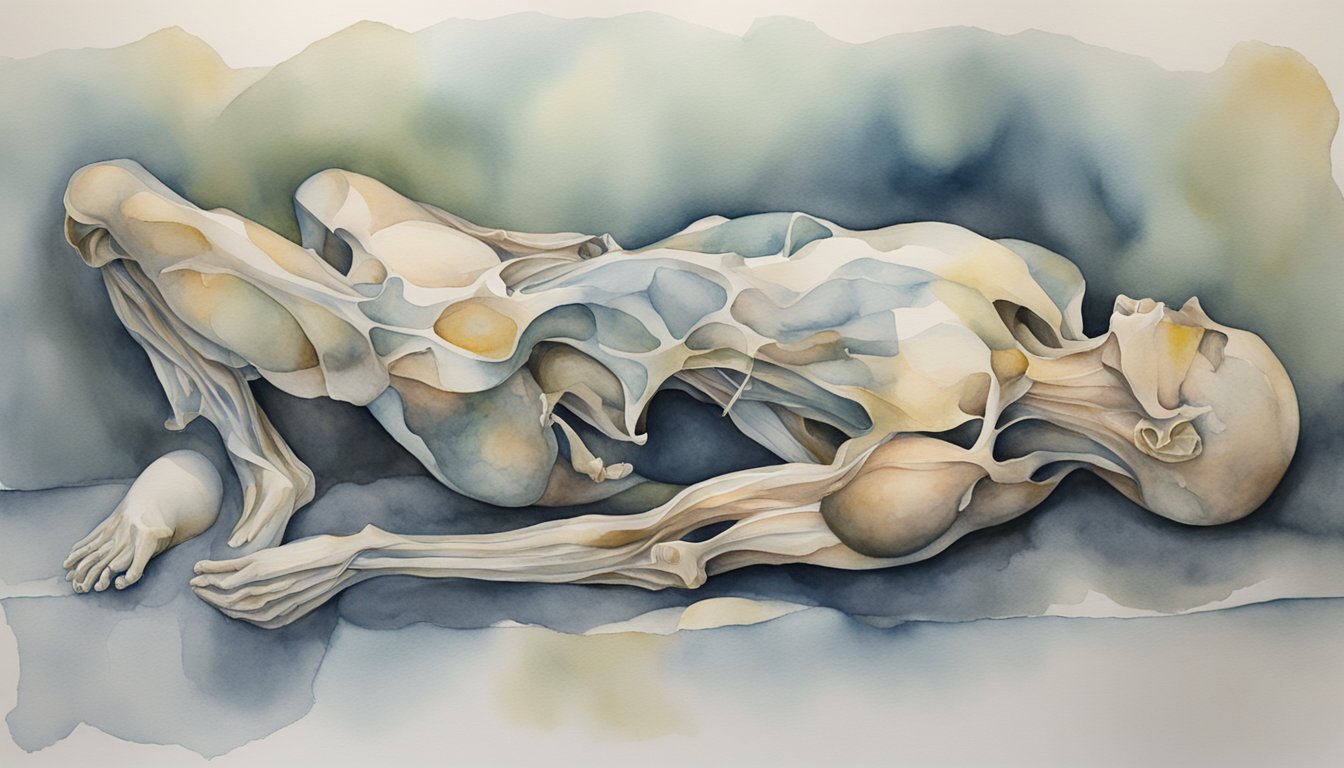Understanding Death
When we discuss what happens as life ends, we’re delving into an inevitable biological transition marked by several distinct physiological changes. Understanding this transition involves the biological process behind death and the implications for brain function and consciousness.
Biological Process
Death is the cessation of the critical functions that sustain life, including heartbeat and respiration. Once the heart stops beating, blood pressure drops to zero, blood flow ceases, and the body starts losing warmth, leading to a decline known as algor mortis. Without the circulation of oxygen-rich blood, cells deteriorate rapidly, and within a few hours, rigor mortis sets in as calcium leaks into the muscles, causing stiffening.
- Livor mortis is another postmortem sign, where gravity pulls the blood to the lowest parts of the body, creating a purplish coloration on the skin.
The dying process encapsulates these phenomena, gradually progressing as the body’s systems shut down.
Brain Function and Consciousness
Brain activity is central to our consciousness and perceptions, but during death, it undergoes significant changes. The exact moment of brain death is clinically defined when there is a total lack of brain activity, as measured by EEG, and this coincides with the loss of reflexes and unresponsiveness of pupils to light. At the moment of death, as oxygen supply halts, brain cells endure a rapid decline, leading to the ceasing of all brain functions. Here’s what happens to the brain in bullet points for clarity:
- Deprivation of oxygen leads to a loss of consciousness.
- Brain waves, detectable by EEG, can flatline in the case of brain death.
- Pupils dilate as the brain no longer controls the iris muscles.
While they may stay alive for a short period after heart activity stops, the cells ultimately fail without oxygen, signifying the end of mental processes and awareness.
The Dying Experience

As life’s final chapter nears, the dying experience encompasses significant physical changes and profound psychological aspects that transform a person’s consciousness and bodily functions.
Physical Changes
At the twilight of life, physical changes manifest as the body begins to shut down. The breathing pattern changes; it may become more labored or irregular—a phenomenon often referred to as Cheyne-Stokes respiration. In some cases, a death rattle, the sound caused by the body’s inability to clear secretions, can be heard. This is neither painful nor uncomfortable for the person, but it might be disconcerting to loved ones nearby.
Similarly, fatigue escalates, and responsiveness to the environment decreases, leading to periods of unresponsiveness. The body’s necessity for medication, especially for pain management, may increase to ensure comfort. To address discomfort, pain medication, like morphine, is carefully administered for palliation without accelerating death.
- Breathing: Becomes irregular, Cheyne-Stokes
- Death Rattle: No discomfort to patient
- Fatigue: High, with increased unresponsiveness
- Medication: Pain management is prioritized
Psychological Aspects
The mind goes through a fascinating transition during the dying process. Some individuals report near-death experiences, which might include vivid hallucinations or feelings of euphoria. These are thought to be a part of how the brain processes the end of life but are not experienced by everyone.
The mind‘s journey doesn’t always align with the body’s shutdown. Patients may remain conscious of their surroundings well into the progression of physical decline and will often cling to the voice or touch of loved ones as their last sense that remains engaged. These interactions can be a critical aspect of comfort for those nearing the end.
- Consciousness: Can persist despite physical decline
- Near-Death Experiences: Include hallucinations or euphoria
- Mind and Loved Ones: The last sense to remain is often hearing
Post-Mortem Changes

When a person’s life ends, their body undergoes a complex series of changes, collectively known as post-mortem changes. These include the onset of decomposition, a shifting palette of skin colors, and various processes that may intervene, such as embalming or cremation.
Decomposition Process
Decomposition is nature’s efficient method of recycling, and it begins almost immediately after death. The first visible sign is a change in skin color due to blood settling, known as livor mortis. As time progresses, the body bloats and internal decay signifies the work of bacteria and enzymes, naturally breaking down bodily tissues. Decay is then accelerated by factors like ambient temperature and the presence of insects.
Scientists have extensively studied the stages of decomposition at facilities known as body farms. These research sites provide vital information on decay which aids legal investigations. At these facilities, one can observe how an unaltered body decomposes in various conditions versus one that has been embalmed. Embalming slows the process, which is primarily done by funeral homes to preserve the body for viewings and services.
Legal and Ethical Considerations
The transition from life to death brings about not only physical changes but also a host of legal and ethical considerations. Choices about burial or cremation reflect personal and cultural beliefs. Funeral homes partner with families in implementing end-of-life preferences, often made in advance during end-of-life planning.
Patients with long-term illnesses, like cancer, may experience changes in appetite and require palliative care. This form of care focuses on comfort and quality of life and often precedes the need for discussions about the physical post-mortem changes. These discussions are crucial and ensure that the deceased’s wishes are respected, whether they prefer a traditional burial, embalming, or alternative methods like cremation.
Cultural and Personal Beliefs

Cultural and personal beliefs play a pivotal role in shaping how individuals perceive what happens after death, encompassing a variety of afterlife perspectives and guiding rituals and traditions.
Afterlife Perspectives
Across cultures, views on the afterlife vary greatly. Some believe in a form of spiritual existence after death, where the soul embarks on a new journey. In many Eastern philosophies, death is seen as a transition rather than an end, with the possibility of reincarnation shaping their understanding of life’s continuity. On the contrary, certain Western belief systems conceptualize the afterlife as a final destination, either of eternal rest or reward.
Rituals and Traditions
Rituals surrounding death and dying are deeply rooted in cultural contexts. They reflect respect for the deceased and provide comfort for loved ones. Traditions may include burial or cremation, often influenced by religious beliefs. For instance, some cultures prefer cremation to liberate the soul from the physical body. Others adhere to burial practices that involve elaborate ceremonies. Regardless of the method, the role of a funeral home is central in many societies, providing services that honor the deceased and support the grieving family.
Through these practices, whether it’s the careful preparation of the skin for viewing or the specific steps of a funeral procession, cultures express their unique perspectives on honor, memory, and the celebration of life.

